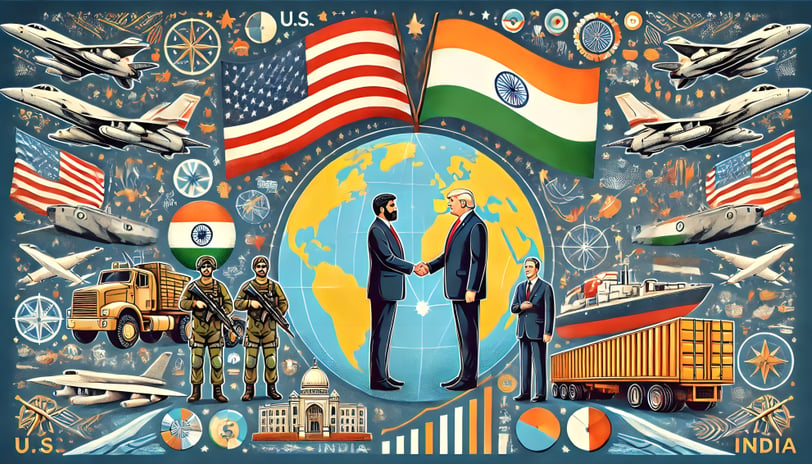Trump-Modi Meet may Alter Geopolitics in Indo-Pacific Region
The Trump-Modi meet that concluded on Thursday (February 13, 2025) may prove a potential milestone for a far-reaching impact in the trade and politics of Indo-Pacific region.
EXPERT ANALYSIS
GeopoliticsTv Team
2/15/20254 min read


The Trump-Modi meet that concluded on Thursday (February 13, 2025) may prove a potential development for a far-reaching impact in the trade and politics of Indo-Pacific region.
By deepening the strategic relations and bilateral trade with India that includes supply of defense equipment among other things, the U.S. may be aiming directly at its arch trade rival China, while India may have been forced to flex its military muscles in the region.
China is already passing through a very rough weather with the U.S. after U.S. President Donald Trump imposed additional 10% tariff on all imports from China.
However, in a tit-for-tat, China had responded to the U.S. tariff with a tariff. China immediately imposed 10% additional tariff on some imports from the United States. On luxury vehicles from the U.S., the total tariff in China has thus gone upto 25%, which negatively affect the major American automakers like General Motors and Ford, at present not so comfortably placed in China market.
Trump had warned India too, of a possible tariff, terming it an “abuser of tariff”. Rushing to ward off the Trump tariff, India had lowered its high tariff on some U.S. goods that included imports from U.S. is luxury liquor brands—bringing it down from 150%, to 75%. India is a huge market for imported liquor and luxury alcohol from the United States include whiskey, scotch, rum, gin, vodka and tequila. U.S. cars exported to India currently attracts a tariff of 70%, which again is pretty high that the U.S. would like India to review. India now has an average tariff of 9.5% on all other goods from the United States.
The Joint Statement of U.S.-India
India Prime Minister Narendra Modi and U.S. President Donald Trump held a meet in Washington during the former’s State visit on February 12-13. After the meet, the two nations announced the areas of bilateral trade and cooperation through a joint statement on February 13.
As expected, Trump wants India to buy more defense equipment and the joint statement showed that India agrees on that. The two nations plan to sign this year a new “ten-year Framework for the U.S.-India Major Defense Partnership in the 21st Century”. India will integrate in its military U.S.-origin defense items like C 130J Super Hercules, C 17 Globemaster III, P 8I Poseidon aircraft; CH 47F Chinooks, MH 60R Seahawks, and AH 64E Apaches; Harpoon anti-ship missiles; M777 howitzers; and MQ 9Bs.
The U.S. also would be co-producer with India in defense industrial cooperation. List of defense equipment also includes maritime patrol aircraft to enhance India’s maritime surveillance. Defense technology cooperation too is in the list.
What would be the impact of U.S.-India defense deal in the region?
The new U.S.-India defense deal will increase the military power of India in Indo-Pacific region while it increases the economy of the United States. But it surely will force China to engage itself more in its military enhancement. The new deal does have in it the capacity to heighten sort of arms race in Indo-Pacific region, between China and India.
With China a natural ally of Russia, and now India entering with the U.S. in defense deal and defense technology cooperation, India’s relationship with Russia too will undergo a change in future.
India is close to Russia as well, and in the past Russia has provided military aid to India whenever it needed. Thus, India will have to balance its position with Russia too, if Russia so feels so in future.
In any case, the fresh U.S. sanctions on Russian ships supplying oil to China and India, have already created problems. The U.S. wants India to purchase oil and gas from her. According to the joint statement after Trump-Modi meet, the “U.S.-India Energy Security Partnership”, includes in areas of oil, gas, and civil nuclear energy. This is very much in line with Trump’s declared policy of ‘drill baby drill’, wherein the U.S. would like more and more nations to consume its energy. This again will call for reshaping of Russia-India bilateral trade and political relations.
U.S.-India Trade and Investments
Trump-Modi meet envisages a new bilateral trade goal of $500 billion by 2030—which at present is little more than $129 billion, in which India has a trade surplus of around $36 billion. Both the nations will work on reducing tariff and non-tariff barriers, and deepen supply chain integration.
Indian mangoes and pomegranates are liked in the United States, trade of which will continue to proliferate.
Trump wants a balance in trade and wants India to buy more from the United States. If the automobile market in India is looked at, a huge chunk of it is with South Korea, Japan and China. Lowering tariff on U.S. vehicles will not just benefit Indian consumers but benefit the U.S. economy too, though at the cost of other nations. The automobile market in India is all set to get bigger in the coming days.
Can India benefit U.S.’s strained relations with China, Mexico and Canada?
Possibly yes, if India steps up its productions in areas that the top three partners of the U.S. had been trading with. Trump has announced tariff of 25% on Mexico and Canada. The additional 10% tariff on all Chinese imports is already in place.
This new partnership, however, holds the potentials of brining up major blow upon China, and alter Indo-Pacific trade and politics. By immediately responding to Trump’s tariff threat, India may have scored upon its regional competitor China as of now. As the deal includes purchase of U.S.-arms by India, China will get more security concerned in the coming days, and fall-outs may be noticed in China-India border disputes resurfacing.
